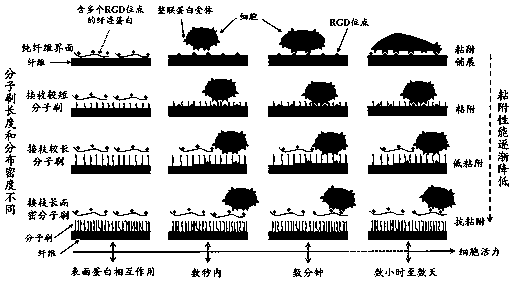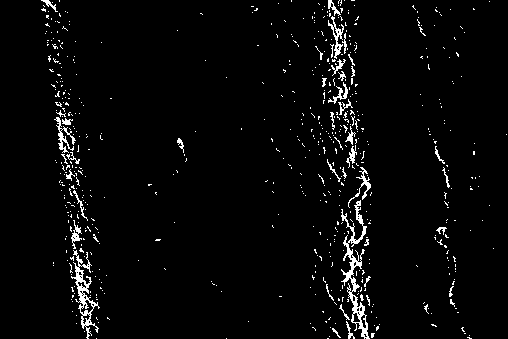Preparation method of low-adhesion wound dressing
A wound dressing and low-adhesion technology, applied in medical science, absorbent pads, textiles and papermaking, etc., can solve the problems of difficult control of the thickness of the gel layer, restricting development, and easy detachment of the gel layer to achieve excellent anti-adhesion Effect, avoid secondary trauma, long-lasting effect of adhesion effect
- Summary
- Abstract
- Description
- Claims
- Application Information
AI Technical Summary
Problems solved by technology
Method used
Image
Examples
Embodiment 1
[0029] A preparation method of low-adhesion wound dressing, the specific steps are:
[0030] (1) Dissolve 6 mL of triethylamine (4.38 g) and 1 g of 4-dimethylaminopyridine in 100 mL of dry tetrahydrofuran successively, immerse 2 g of cotton fabric in the above solution at a bath ratio of 1:50, and control the temperature of the solution At 0-5°C, slowly add 4.58mL of 2-bromoisobutyryl bromide (8.52g) dropwise, react for 2 hours, then raise the temperature to 25°C, continue the reaction for 12 hours, and wash with tetrahydrofuran, ethanol and deionized water by ultrasonic oscillation for 15 minutes. Vacuum drying at 60° C. for 12 hours to obtain a cotton fabric macromolecular initiator.
[0031] (2) Take 90 mL of ethanol-water mixed solution with a volume ratio of 1:1, add 22.4 mg of copper bromide (0.10 mmol), 68 μL of pentamethyldiethylenetriamine (0.32 mmol) and 5.0 g of N-isopropyl Acrylamide (44.25 mmol), and then add 2 g of the above cotton fabric macroinitiator at a liq...
Embodiment 2
[0033] A preparation method of low-adhesion wound dressing, the specific steps are:
[0034] (1) Dissolve 6 mL of triethylamine (4.38 g) and 1 g of 4-dimethylaminopyridine in 100 mL of dry tetrahydrofuran successively, immerse 2 g of cotton fabric in the above solution at a bath ratio of 1:50, and control the temperature of the solution At 0-5°C, slowly add 4.58mL of 2-bromoisobutyryl bromide (8.52g) dropwise, react for 2 hours, then raise the temperature to 25°C, continue the reaction for 24 hours, and wash with tetrahydrofuran, ethanol and deionized water for 15 minutes by ultrasonic oscillation. Vacuum drying at 60°C for 24 hours to obtain a cotton fabric macromolecular initiator.
[0035](2) Take 90 mL of ethanol-water mixed solution with a volume ratio of 1:0.5, add 22.4 mg of copper bromide (0.10 mmol), 68 μL of pentamethyldiethylenetriamine (0.32 mmol) and 10.0 g of N-isopropyl Acrylamide (88.50 mmol), and then add 2 g of the above cotton fabric macroinitiator at a bat...
Embodiment 3
[0037] A preparation method of low-adhesion wound dressing, the specific steps are:
[0038] (1) Dissolve 9 mL of triethylamine (6.57 g) and 1.5 g of 4-dimethylaminopyridine in 100 mL of dry tetrahydrofuran successively, immerse 2 g of cotton fabric in the above solution at a bath ratio of 1:50, and control the temperature of the solution At 0-5°C, slowly add 4.58mL of 2-bromoisobutyryl bromide (8.52g) dropwise, react for 2 hours, then raise the temperature to 25°C, continue the reaction for 24 hours, and wash with tetrahydrofuran, ethanol and deionized water for 15 minutes by ultrasonic oscillation. Vacuum drying at 60° C. for 12 hours to obtain a cotton fabric macromolecular initiator.
[0039] (2) Take 90 mL of ethanol-water mixed solution with a volume ratio of 1:1.5, add 22.4 mg of copper bromide (0.10 mmol), 68 μL of pentamethyldiethylenetriamine (0.32 mmol) and 15.0 g of N-isopropyl Acrylamide (132.74mmol), and then add 2 g of the above cotton fabric macroinitiator at ...
PUM
 Login to View More
Login to View More Abstract
Description
Claims
Application Information
 Login to View More
Login to View More - R&D
- Intellectual Property
- Life Sciences
- Materials
- Tech Scout
- Unparalleled Data Quality
- Higher Quality Content
- 60% Fewer Hallucinations
Browse by: Latest US Patents, China's latest patents, Technical Efficacy Thesaurus, Application Domain, Technology Topic, Popular Technical Reports.
© 2025 PatSnap. All rights reserved.Legal|Privacy policy|Modern Slavery Act Transparency Statement|Sitemap|About US| Contact US: help@patsnap.com



